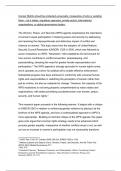Human Rights should be protected universally, irrespective of who is violating
them – be it states, regulatory agencies, private actors, international
organisations, or global governance bodies.
The Women, Peace, and Security (WPS) agenda emphasises the importance
of women's equal participation in fostering peace and security by addressing
and resolving the disproportionate and distinctive impact of conflict and
violence on women. This topic arose from the adoption of United Nations
Security Council Resolution (UNSCR) 1325 in 2000, which was followed by
seven resolutions on WPS.1 Resolution 1325 establishes the benchmark for
how women contribute to conflict prevention, peacekeeping, and
peacebuilding, stressing the need for greater female representation and
participation.2 The WPS agenda is strongly grounded in human rights norms,
and it operates as a driver for political will to enable effective enforcement.
Substantial progress has been achieved in conformity with universal human
rights and responsibilities in redefining the perception of women rather than
just as victims, but also as catalysts for change.3 However, the capacity of the
WPS resolutions is not being properly comprehended by nation states and
organisations, with states prioritising counterterrorism over women, peace,
security, and human rights.4
This research paper proceeds in the following manner. It begins with a critique
of UNSCR 2242 in relation to reinforcing gender relations by placing it at the
forefront of the WPS agenda, and how a contextualised approach to WPS is
more appropriate. Building on feminist critique of the WPS agenda, this paper
goes onto argue that a human rights strategy needs to be advanced which
pursues gender equality, irrespective of whether conflicts erupt or not, as well
as how an increase in women’s participation may not necessarily transform
1
UNSC Res 1325 (31 October 2000) UN Doc S/RES/1325 (n 130).
2
Melissa Labonte and Gaynel Curry, 'Women, Peace, and Security: Are We There Yet'
(2016) 22(3) Global Governance 311.
3
Ibid, 312.
4
Elizabeth Pearson, "Between Protection and Participation: Affect, Countering Violent
Extremism and the Possibility for Agency." New Direction in Women Pease and
Security (2020): 91-110.
, structural gender inequality.5 This paper will go on to draw a comparison
between a global north, the UK, and a global south country, Afghanistan, and
the different ways in which national action plans (NAPs) have been
implemented and the results that they have achieved. This research paper will
then conclude by stating that whilst there has been an increase in promoting
women’s rights, there is the requirement to view it through a human rights
perspective to ensure that there is no reinforcement of unequal gender
dynamics.
CRITIQUE OF UNSCR 2242 AND THE CRITICISM OF GENDER AT THE
FOREFRONT
Since the passing and implementation of UNSCR 1325, many complementary
resolutions were officially passed with the purpose of solving the deficiencies
clearly indicated in UNSCR 1325 as well as enhancing gender mainstreaming
in the midst of a conflict-ridden state, reconciliation, and peace building.
Largely based on initial consultation with 'women, gender sensitive data
collection, and an emphasis on the goals of women's participation,
empowerment, and leadership', the UNSCR advocated for the integration of
WPS objectives in counterterrorism and counter-violent extremism (CVE)
initiatives.6 Gross human rights violations against women and men predates a
state in conflict, which puts forth the notion that militarised violence and
violations of human rights have the capacity to exist before and after the
formal recognition of 'hostilities'.7 Any strategy must incorporate post-conflict
changes in social economic disparities, as well as institutional and political
differences affecting the lives of women and men. Cornwall argues that by
increasing women's involvement in the formulation and implementation of
policies as well as within decision-making processes, it has the capacity to
give women sense of acknowledgment as both victims and as essential
producers of social and political changes.8 Multiple perspectives on human
5
Isobel Renzulli, ‘‘Women and peace’: A human rights strategy for the women, peace and
security agenda’ Netherlands Quarterly of Human Rights (2020) 38(1), 43-62.
6
Ibid 4, 93.
7
Doris Buss and others, Sexual Violence in Conflict and Post-Conflict Societies (2014), 5.
8
Andrea Cornwall, ‘Women’s empowerment: What works?’ (2016) 28(3) Journal of
International Development, 354.




